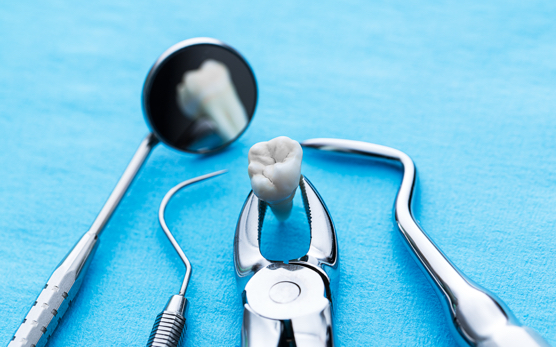Oral Surgery
Removal of tooth, wisdom tooth and bone replacement
Tooth and Wisdom Tooth Extraction
In many people’s minds, wisdom tooth removal is the most horrible dental procedure.
We are here to to prove that this is in fact not true!
First of all, when the surgery is in the hands of a specialist with experience and specific qualifications in operations of the sort the procedure should only require a fragment of the usual treatment time. Not only time but the quality and amount of complications (swelling, pain) are also closely related to professional execution.
On the other hand modern medicine has a special focus on pain-free treatments. In the simplest cases, a special injection of local anaesthetic provides complete insensibility.
If there is any reason to do so (inflammation or increased fear) the procedure can be performed under conscious sedation (anaesthesia). In such cases, the entire procedure will be supervised by an anaesthesiologist.
It is possible to remove wisdom teeth one by one, but we can also carry out many extractions in one sitting. Strain and consequences depend on the level of intervention.
The patient will of course be informed about the course and details of the procedure in verbal and written form.

Bone Replacement
T
The fundamental condition for implantation is that the bone is of sufficient size to accommodate the whole implant. If this condition is not met due to previous bone loss, bone grafting may be required prior to or at the same time as the implantation process.
In an area that has remained toothless for a long time after tooth extraction, especially if the patient is wearing removable denture or if teeth have been removed due to periodontical disease the bone may have degraded to such an extent that it becomes impossible to embed an artificial root. However, there are few cases, in which we cannot help. There are several ways of rebuilding the missing bone. The nature of the planned replacement, the size and exact location of the bone defect determines which solution we choose.
In the simplest case, with the so-called guided bone regeneration method a suitable position is created to receive implants using bone grafting material and membrane. This can be done in the area of the extracted tooth in the sinus, possibly at the same time as the implantation.
In the case of a more extensive bone deficit, we remove an adequate amount of bone from the jaw bone or the hip and attach it to the area of deficit so the bone will be able to accommodate the implant. (see below: bone transplantation)
In some cases, we can replace the deficiency with bone carved in 3D, designed to match the size of the missing part perfectly. (see: high-tech surgery)
The type of anaesthetic used depends on the seriousness of the procedure. It is not the pain, but rather the extended surgical time that makes the assistance of an anaesthesiologist necessary. For bone transplantation, full narcosis is usually the best option.
Bone Substitutes
In some cases of bone deficit, bone regeneration can be achieved through the use of bone replacement material. These substances fill the area of the deficit and maintain the desired volume until the area is populated by bone-forming cells and bone tissue is formed.
Membranes
Membranes are used in guided tissue regeneration (bone replacement) to keep the granular bone replacement substance in place and protect the area that is rejuvenating beneath them. With some rare exceptions, usually an absorbable membrane is used.
Sinus Lift
One of the safest ways to restore bone is filling the area of the bone that was occupied by the sinus after the tooth extraction. This ensures that bone deficiency in the lateral part of the upper jaw bone can be treated safely, allowing the placement of an implant of sufficient length.
Bone Transplantation
In cases of severe bone deficiency, the "gold standard" of bone replacement is utilising one’s own bone tissue. To widen bone it is often sufficient to use a block of bone removed from the jaw behind the lower teeth, but often the hipbone is the only part that can supply enough bone material to allow later implantation. These usually require hospitalisation and anaesthesia, but while the procedure may sound alarming, as a matter of fact, the vast majority of patients’ experience is positive, and any discomfort associated with surgery is not actually related to pain, but rather to the temporary replacement of teeth. However, we often find solutions to these problems that are well suited to everyday life.